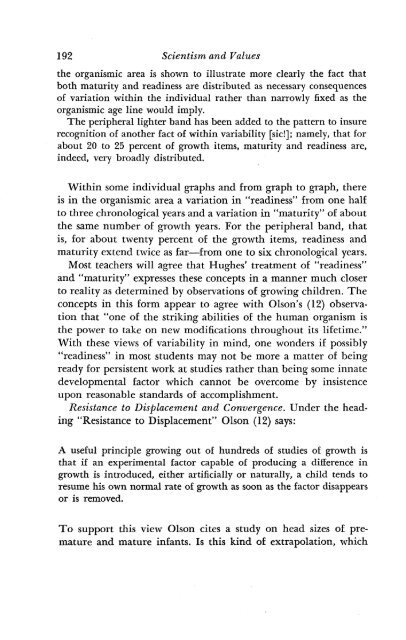Scientism and Values.pdf - Ludwig von Mises Institute
Scientism and Values.pdf - Ludwig von Mises Institute
Scientism and Values.pdf - Ludwig von Mises Institute
Create successful ePaper yourself
Turn your PDF publications into a flip-book with our unique Google optimized e-Paper software.
192 <strong>Scientism</strong> <strong>and</strong> <strong>Values</strong><br />
the organismic area is shown to illustrate more clearly the fact that<br />
both maturity <strong>and</strong> readiness are distributed as necessary consequences<br />
of variation within the individual rather than narrowly fixed as the<br />
organismic age line would imply.<br />
The peripheral lighter b<strong>and</strong> has been added to the pattern to insure<br />
recognition of another fact of within variability [sid]; namely, that for<br />
about 20 to 25 percent of growth items, maturity <strong>and</strong> readiness are,<br />
indeed, very broadly distributed.<br />
Within some individual graphs <strong>and</strong> from graph to graph, there<br />
is in the organismic area a variation in "readiness" from one half<br />
to three chronological years <strong>and</strong> a variation in "maturity" of about<br />
the same number of growth years. For the peripheral b<strong>and</strong>, that<br />
is, for about twenty percent of the growth items, readiness <strong>and</strong><br />
maturity extend twice as far-from one to six chronological years.<br />
Most teachers will agree that Hughes' treatment of "readiness"<br />
<strong>and</strong> "maturity" expresses these concepts in a manner much closer<br />
to reality as determined by observations of growing children. The<br />
concepts in this form appear to agree with Olson's (12) observation<br />
that "one of the striking abilities of the human organism is<br />
the power to take on new modifications throughout its lifetime."<br />
With these views of variability in mind, one wonders if possibly<br />
"readiness" in most students may not be more a matter of being<br />
ready for persistent work at studies rather than being some innate<br />
developmental factor which cannot be overcome by insistence<br />
upon reasonable st<strong>and</strong>ards of accomplishment.<br />
Resistance to Displacement <strong>and</strong> Convergence. Under the heading<br />
"Resistance to Displacement" Olson (12) says:<br />
A useful principle growing out of hundreds of studies of growth is<br />
that if an experimental factor capable of producing a difference in<br />
growth is introduced, either artificially or naturally, a child tends to<br />
resume his own normal rate of growth as soon as the factor disappears<br />
or is removed.<br />
To support this view Olson cites a study on head sizes of premature<br />
<strong>and</strong> mature infants. Is this kind of extrapolation, which
















